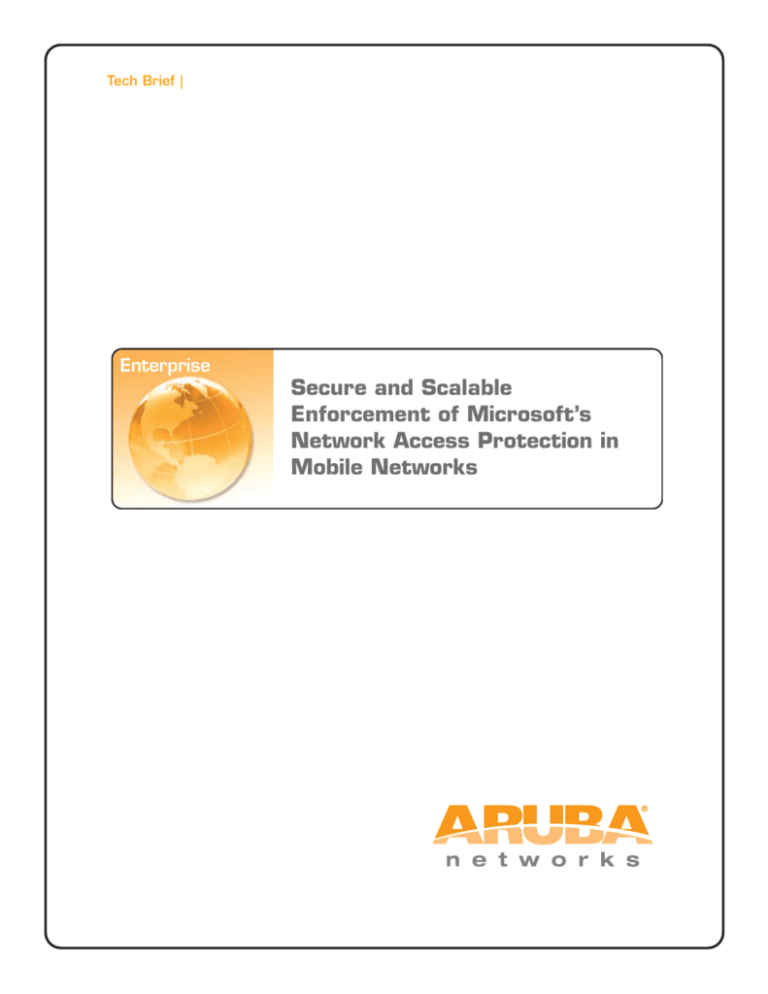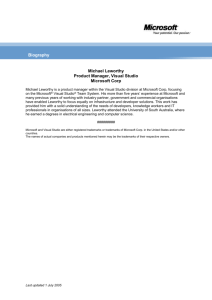
Tech Brief |
Enterprise
Secure and Scalable
Enforcement of Microsoft’s
Network Access Protection in
Mobile Networks
Introduction
In today’s era of increasing mobile computing, one of the greatest challenges to businesses is the increasing exposure of
client devices to malicious software such as viruses, worms, and spyware. No longer are user devices primarily desktop
systems that remain behind a corporate firewall and in contact with IT management systems at all times. Instead,
companies increasingly outfit their employees with wireless-equipped laptops, PDAs, and other mobile devices that
regularly leave the corporate network and attach to networks at homes, public wireless hotspots, hotels, and partner
sites. When these devices return to the corporate network, any malicious software they may be carrying can be spread
to other corporate systems. For this reason, ensuring that these devices are properly protected from malicious software
has become a key interest of IT departments.
As a major provider of network systems that enable the new “mobile edge” of the enterprise network, Aruba Networks
has partnered with Microsoft® to support Network Access Protection for mobile users. Network Access Protection for
Windows Vista™ (now in beta testing) and Windows Server® “Longhorn” (now in beta testing) is a platform technology
designed to provide the ability to protect networked assets from connecting or communicating clients by enforcing
compliance to network access and health requirement policies, determining access based upon validated health state,
and coordinating endpoint remediation services to ensure ongoing compliance.
Mobile Edge Architecture – Common User Experience across LAN, WAN and Internet
Microsoft Network Access Protection builds policy enforcement capabilities into the Windows Vista and Windows Server
"Longhorn" operating systems that allow Aruba’s system of mobility controllers and controlled wired and wireless access
Aruba Wireless Networks & Microsoft Corp.
Secure & Scalable Enforcement
Of Microsoft’s NAP in Mobile Networks
1
points to enforce limited network access conditions for non-compliant devices. Once in a limited access state, Network
Access Protection provides for automatic remediation to bring client devices back into compliance. For client devices
that do not yet support Network Access Protection, Aruba mobility controllers can enable network-based inline services
such as virus scanning and malware removal to protect the network from non-compliant clients.
Identity-based Security for Flexible Policy Enforcement
The mobile edge secures people, not ports. Because users are mobile, the network must adapt to
multiple access methods and must identify the user or device through authentication. ArubaOS
supports Universal Authentication, allowing simultaneous use of different authentication and
encryption methods. Combined with multiple methods of policy enforcement provided by Microsoft
Network Access Protection, administrators are able to support large heterogeneous user bases
without a need for increased support personnel. Customers have a choice to implement Network
Access Protection using enforcement mechanisms best suited to their threats and risks, existing
infrastructure, and infrastructure upgrade schedule.
Network Access
Method
After Connection /
Open System
802.1X
VPN
Application
Guest access, public access, or networks
with minimal security requirements
Wired or wireless access with strong
encryption and authentication
Remote access, access with minimal
client configuration
NAP Enforcement Option
DHCP or IPsec
802.1X
VPN
Protect network access, host access, application access, in any combination, as needed, and where
appropriate.
MOBILE EDGE ARCHITECTURE WITH MICROSOFT NETWORK ACCESS
PROTECTION
Combined with Microsoft Network Access Protection, Aruba’s line of centralized mobility controllers serve as effective
policy control points in the network. Network traffic from mobile users is concentrated and processed in the mobility
controller, where it can be managed with policy rules configured on the Microsoft Network Policy Server. Powering each
mobility controller, the ArubaOS operating system provides the following functionality to enhance Network Access
Protection:
•
Identity-based Security applies policies and rules based on user identity rather than physical port, IP
address, or MAC address. By uniquely terminating both encryption and authentication in the same
device, the mobility controller knows with 100% certainty whether a given packet was sent by an
2
Secure & Scalable Enforcement
Of Microsoft’s NAP in Mobile Networks
Aruba Wireless Networks & Microsoft Corp
authenticated user. Even if that user – or malicious software running on that user’s device –
changes a MAC or IP address, the mobility controller still applies the same policy.
•
Stateful Per-User Firewall gives each user or device a unique set of firewall policies to tightly control
network access. ArubaOS implements a full stateful ICSA-certified firewall in hardware to apply
flexible rules based on source address, destination address, type of service, time of day, physical
location, authentication method, and user identity.
•
Universal Authentication permits devices to authenticate to the network in multiple ways. Aruba
mobility controllers support 802.1X authentication, VPN authentication, and Captive Portal webbased authentication simultaneously over the same wired port or wireless SSID. In this way, clients
connecting to a wired port or to a wireless SSID can use whatever authentication protocol for which
they are configured, meaning that no client is locked out of the network.
•
External Services Interface for clients not yet upgraded to support Network Access Protection
provides a link to external systems that provide network-based security services such as virus
scanning, content transformation, spyware removal, and intrusion detection. Rather than
completely isolating non-compliant clients from the network, or being forced to create exceptions
to access policies for legacy clients, the External Services Interface allows administrators to give
access to these devices while still protecting the network.
Aruba and Microsoft Network Access Protection Architecture
Aruba Wireless Networks & Microsoft Corp.
Secure & Scalable Enforcement
Of Microsoft’s NAP in Mobile Networks
3
Microsoft Network Access Protection is best illustrated by the diagram above. Here’s how it works:
1. The Client requests access to the network through a wireless or wired network and is requested to
authenticate. Login credentials are supplied, and during the login process the client’s NAP Agent
presents its current health state (e.g. “Here is my current antivirus signature, patch level, firewall
configuration.”).
2. The Aruba mobility controller forwards the authentication credentials and health state information
using the RADIUS protocol to the Network Policy Server (a Microsoft RADIUS server), which
validates the health state information against defined policies.
3. If the Client is not compliant with health requirement policy, the Microsoft NPS server sends limited
network access configuration information to the Aruba mobility controller, which places the client in
a “role” with restrictive firewall policies. The client has limited access to the network or any other
clients, and is redirected to get updates from remediation servers. The client requests and receives
the updates and starts over with step 1.
4. If the Client is compliant with health requirement policy, it is granted access to the network
according to its business needs, e.g. a sales user is granted access to sales servers while access
to finance networks and servers is blocked.
BENEFITS OF A COLLABORATIVE SOLUTION
A collaborative effort between Microsoft and Aruba Networks means that aggregated benefits accrue to our common
customers. A defense solution acting at multiple layers and focusing on health and policy validation means that only
healthy endpoints connect—effectively decreasing unwanted risks to networked assets.
Enhanced Security
•
All connection and communication attempts are encrypted, authenticated, authorized, and
compliant with health requirements
•
Customers can deploy the enforcement mechanism according to risk level and business need
•
The IT administrator gains the control and visibility to set, check, and enforce health requirements
and access policies
Increased Business Value
•
4
Enhanced user productivity through mobility and reduced downtime
Secure & Scalable Enforcement
Of Microsoft’s NAP in Mobile Networks
Aruba Wireless Networks & Microsoft Corp
•
Lowering of required IT resources through automated ongoing and per-connection client health
remediation
•
Broad industry integration delivers an interoperable, multi-vendor, end-to-end solution
•
No change to the underlying network infrastructure is required, allowing customers to leverage
investments in existing infrastructure
SOLUTION TIMELINE
General availability of Aruba solution offering and Microsoft Network Access Protection:
The full functionality of Network Access Protection will be available as part of the next version of Windows client and
server releases. NAP client support is also planned for Windows XP and Windows Server 2003. Support in ArubaOS is
available immediately.
SYSTEM REQUIREMENTS
Microsoft
•
Windows XP or Windows Vista
•
Windows Server “Longhorn”
•
Network Policy Server (Microsoft’s RADIUS server. A component of Windows Server “Longhorn”)
•
Active Directory (Microsoft’s directory service. A component of Windows Server “Longhorn”)
Aruba Networks
•
Aruba Mobility Controller (200, 800, 2400, or 6000)
•
ArubaOS Policy Enforcement Firewall software module
•
ArubaOS External Services Interface software module (optional)
•
ArubaOS VPN Server software module (optional)
FOR MORE INFORMATION
About Microsoft Network Access Protection, please visit:
http://www.microsoft.com/nap
About Aruba Networks, please visit:
http://www.arubanetworks.com
Aruba Wireless Networks & Microsoft Corp.
Secure & Scalable Enforcement
Of Microsoft’s NAP in Mobile Networks
5
About Aruba Networks, Inc.
Aruba securely delivers the enterprise network to users, wherever they work or roam, with user-centric networks that
significantly expand the reach of traditional port-centric networks. User-centric networks integrate adaptive WLANs,
identity-based security, and application continuity services into a cohesive, high-performance system that can be easily
deployed as an overlay on top of existing network infrastructure. Adaptive WLANs deliver high-performance, follow-me
connectivity so users are always within reach of mission-critical information. Identity-based security associates access
policies with users, not ports, to enable follow-me security that is enforced regardless of access method or location.
Application continuity services enable follow-me applications that can be seamlessly accessed across WLAN and cellular
networks. The cost, convenience, and security benefits of user-centric networks are fundamentally changing how and
where we work. Listed on the NASDAQ and Russell 2000® Index, Aruba is based in Sunnyvale, California, and has
operations throughout the Americas, Europe, Middle East, and Asia Pacific regions. To learn more, visit Aruba at
http://www.arubanetworks.com.
© 2007 Aruba Networks, Inc. All rights reserved. Specifications are subject to change without notice.
Aruba Networks, BlueScanner and RFprotect are trademarks of Aruba Networks, Inc. All other trademarks or registered
trademarks are the property of their respective holders.
Portions © 2005 Microsoft Corporation. Microsoft, Windows, Windows Server and Windows Vista are either registered
trademarks or trademarks of Microsoft Corporation in the United States and/or other countries.
TB_MNAP_US_071217
6
Secure & Scalable Enforcement
Of Microsoft’s NAP in Mobile Networks
Aruba Wireless Networks & Microsoft Corp
1322 Crossman Ave. Sunnyvale, CA 94089-1113
Tel. +1.408.227.4500 | Fax. +1.408.227.4550 | info@arubanetworks.com
http://www.arubanetworks.com
© 2007 Aruba Networks, Inc. All rights reserved. Aruba Networks, BlueScanner and RFprotect are trademarks of Aruba Networks, Inc. All other trademarks or registered trademarks are the property of their
respective holders. All rights reserved. Specifications are subject to change without notice.









